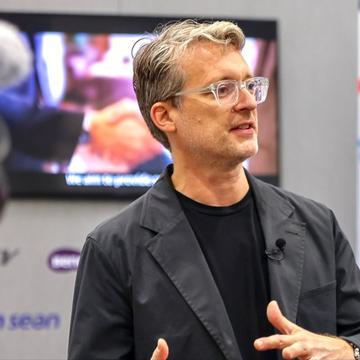Watch “The Televisioning of FAST“ from NAB Show New York.
TL;DR
- Evan Shapiro and Justin Evans discuss the critical role of data analytics and audience engagement in the maturation of Free Ad-Supported Television (FAST).
- Samsung TV Plus, Samsung’s own FAST platform, boasts an average viewer engagement of 110 minutes per day, outperforming the 34-minute average of linear networks.
- The lack of unified, comprehensive data, termed the “dark room phenomenon” by Evans, is a significant challenge hindering the growth of the FAST industry.
- As FAST matures, the focus is shifting toward more sophisticated monetization and audience targeting strategies, including a move from demographic-based to “psychographic”-based selling.
- Shapiro and Evans agree that the FAST ecosystem has significant room for growth, especially in terms of content discoverability and global expansion opportunities.
Free Ad-Supported Television (FAST) is rapidly reshaping the media landscape, but how well do we really understand its potential? Media universe cartographer Evan Shapiro and Justin Evans, global head of analytics & insights at Samsung Ads, examines how data analytics and audience engagement are critical factors steering FAST toward maturity in a fireside chat that goes well beyond the hype.
From debunking myths to highlighting untapped opportunities, the conversation provides a masterclass in understanding the complexities of FAST. Watch “The Televisioning of FAST“ in the video at the top of the page.
The Evolution of FAST: More Than Just Reruns
In just a few short years, FAST has gone from a fledgling concept to a burgeoning industry. Evans paints a vivid picture of this growth, recalling his early days at Samsung Ads. “My team was four-and-a-half people around a card table,” he says. Four years later, the analytics group alone has expanded to 50 people globally across five continents. “So that’s an indicator of how the business has grown.”

More than a platform for merely recycling library titles, FAST is evolving to include fresh content. One of the biggest myths the advertising community has about FAST, says Evans, “is that because we’re used to seeing these single-IP networks, we think of all of the FAST ecosystem as being simply, to use the 80s term, like reruns… and that’s not true.”
Samsung isn’t just a spectator in the FAST arena; it’s a key player with its own platform, Samsung TV Plus. Available as a preloaded app on all Samsung Smart TVs, Samsung TV Plus offers a linear television experience with upwards of 250 channels. The platform covers a wide range of categories, including single-title channels such as the Baywatch channel and the Great British Baking Show channel, as well as entertainment and lifestyle channels like Tastemade. With a reach extending to 24.6 million homes — about 38% of all US TV homes — Samsung TV Plus is a force to be reckoned with, as Shapiro observes, even outpacing giants like Comcast and Charter.

Evans explains how Samsung’s strategy mirrors the moves of big tech companies that started with services and then diversified into hardware. “Samsung is effectively doing that the other way around,” he says. “We have, obviously, an enormous manufacturing, company business. And about nine years ago, they had the clever idea to start a services business. And what that means is we have a group of folks who make the operating system for the smart TVs. We have a team of folks who are licensed in bringing content into the ecosystem. And we have people who put ads on that content to monetize the attention.”
He revealed some eye-opening statistics during the fireside chat. On average, viewers engage with Samsung TV Plus for 110 minutes per day, a figure that dwarfs the 34-minute average of linear networks. This high level of engagement isn’t confined to a few top channels; it’s widespread across the platform’s diverse offerings.
The Data Gap: The “Dark Room Phenomenon”
In the ever-evolving landscape of FAST, one of the most pressing challenges is the lack of comprehensive, unified data. Shapiro points out the absence of a “single source of truth” in the industry, stating that data is often scattered and not easily accessible. This lack of clarity has led to what Evans calls the “dark room phenomenon.”
Evans elaborates, “The lack of data plays a really big part about why some of this is more obscure than it needs to be. And in fact, I would go even further and say the lack of data is a blocker to the business. It’s a bottleneck to the growth of the streaming business.” This “dark room” is a space that agencies and advertisers are hesitant to enter without adequate information, hindering the industry’s growth.
But the data gap doesn’t just affect advertisers; it’s a challenge for publishers as well. Evans discusses the publisher’s journey to convert viewers from “samplers” to “returners” and then to “loyalists.”
“We have solutions to identify people in each category and how to move them up the ladder,” he notes, emphasizing the importance of re-engagement strategies. “Re-engaging a ‘sampler’ at the right time with the right ad can effectively change the bounce rate from 62% to 14%,” he adds.
Third-party measurement companies also come into play. “They play an important role as an impartial referee in the industry,” Evans says, acknowledging the role of companies like Nielsen in providing some level of data standardization.
To help clients navigate this murky data landscape, Samsung Ads has developed a product called Audience Advisor. “It helps clients understand the streaming environment better,” Evans explains.
Both Shapiro and Evans agree that FAST offers better discoverability of new content compared to SVOD services. “FAST allows users to crash into new content,” Shapiro says, attributing this to the grid-like structure of FAST platforms.
The idea of creating a consortium of data from various platforms like Samsung, LG, and others is floated as a potential solution for the lack of a unified data source. “It could serve as a single source of truth,” Shapiro suggests.
“We did measurement and how often people come back and watch the app,” said Evans. “And then when they watch, how long do they watch for? And for me, this is a good indicator of engagement.”
The Road Ahead: Monetization and Audience Targeting in FAST
As the FAST ecosystem matures, the focus is shifting toward more sophisticated monetization and audience targeting strategies. Evans is particularly excited about the potential of content-oriented data. “Now that all of this content is digital, and we can read it from a data perspective, that also means it should be discoverable and almost innumerable ways,” he says. This opens up new avenues for monetization, allowing advertisers to tag and label experiences that can be sold.
But it’s not just about selling; it’s about selling smartly. Shapiro points out the shift from demographic-based selling to “psychographic”-based selling, allowing for a more nuanced understanding of the audience. “Solving the consumer’s conundrum about what to watch next is going to be a key factor,” Shapiro notes, emphasizing that platforms like Samsung are well-positioned to solve this problem due to their central role in living rooms.
The ability to monetize content through audience buying is another exciting frontier. “Now that there’s so much more scale in a FAST environment, each one of those networks can be contributing to reaching that 5-10 to 15% of the audience,” Evans explains. This not only increases the value proposition for advertisers but also opens up new monetization opportunities for networks.
One of the most striking revelations from Evans was about re-engaging samplers. “We’ve introduced solutions to re-engage samplers at the right time with the right ad, effectively changing the bounce rate from 62% to 14%,” he says. This is a game-changer in terms of increasing loyalty and, by extension, ad revenue.
Both Evans and Shapiro agree that there’s a lot of room for growth in the business, especially with more channels being curated into the system. Shapiro even hints at global expansion opportunities, mentioning that Germany is one of the fastest-growing FAST markets.
As the FAST ecosystem continues to evolve, the role of data in shaping its future cannot be overstated. But data alone isn’t the endgame; it’s the lens through which the industry can gain a clearer understanding of itself. “Right now, I’m focused on trying to contextualize the FAST experience for that advertising buyer universe,” Evans says. “That’s where I feel like there’s sort of this education gap. And I think the challenge there is: ‘What’s the perception — or just kind of the fuzziness — in the media and ad community around FAST?’”
FAST continues to mature rapidly, and it’s clear that data analytics will not only illuminate the “dark room” but also pave the way for innovative strategies in monetization and audience engagement — the untapped opportunities that lie ahead.


